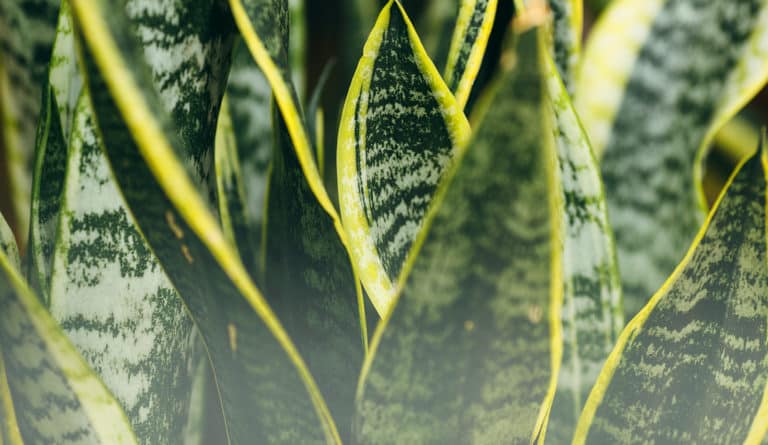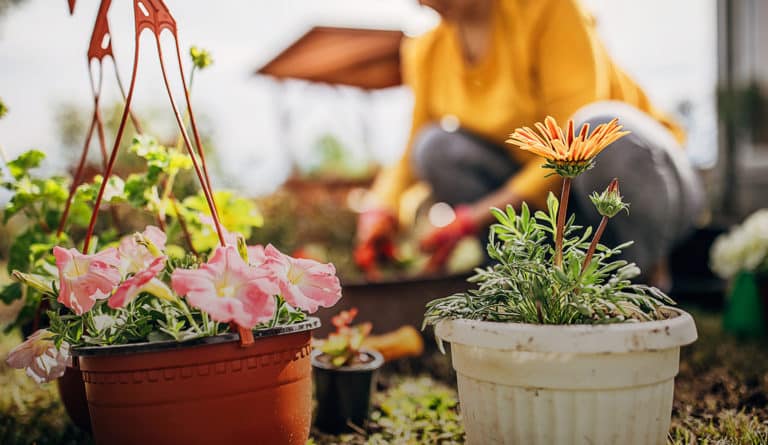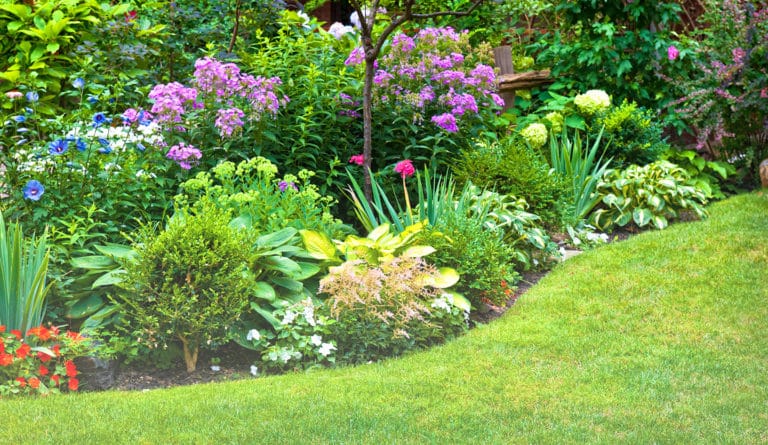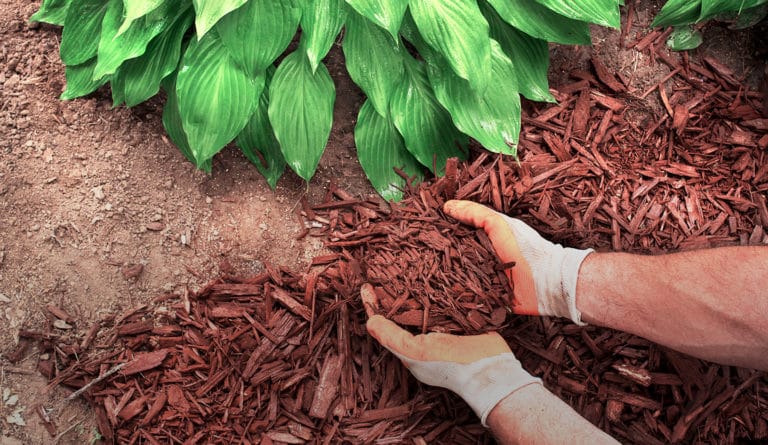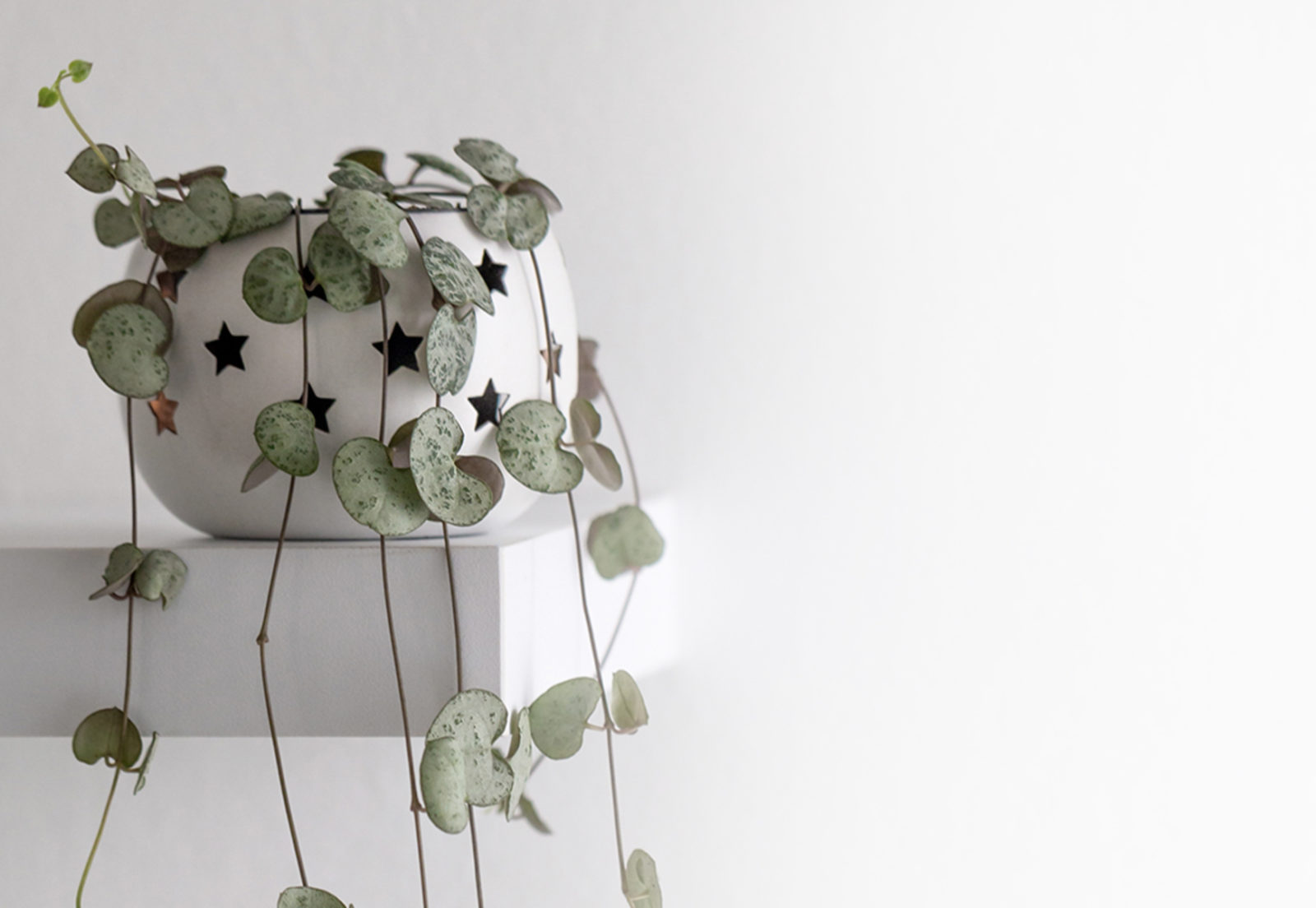
string of hearts
aka ceropegia woodii
this beautiful trailing succulent is native to South Africa, Swaziland and Zimbabwe. This plant is named for the sweet, heart-shaped leaves.
variations
the more sun it gets, the more variegated the leaves will get. Leaves can get silver, cream or even pink markings.
light
bright, indirect.
Ample bright, indirect light will lead to greater variegation in the leaves.
water + feeding
somewhat thirsty
Can be watered 1-2 times a week in the spring and summer, once every week or two during the fall and winter.
toxic
no
This plant is safe for pets.
location
somewhere bright
Place near your brightest window. South or West facing windows is recommended
humidity
not too fussy
Can tolerate drier climate but thrive in about 40-50% humidity.
size
small-ish
Can grow up to 3 inches tall and have trailing stems that can grow to 3 – 9 ft long.
pro tip
sun baths
Colour can be revived by placing your plant by a bright window. Leaves can return to their vibrant colours and even turn pink.
fun fact
fast Growers
They’re fast growers and very easy to care for, making them popular houseplants for beginners.
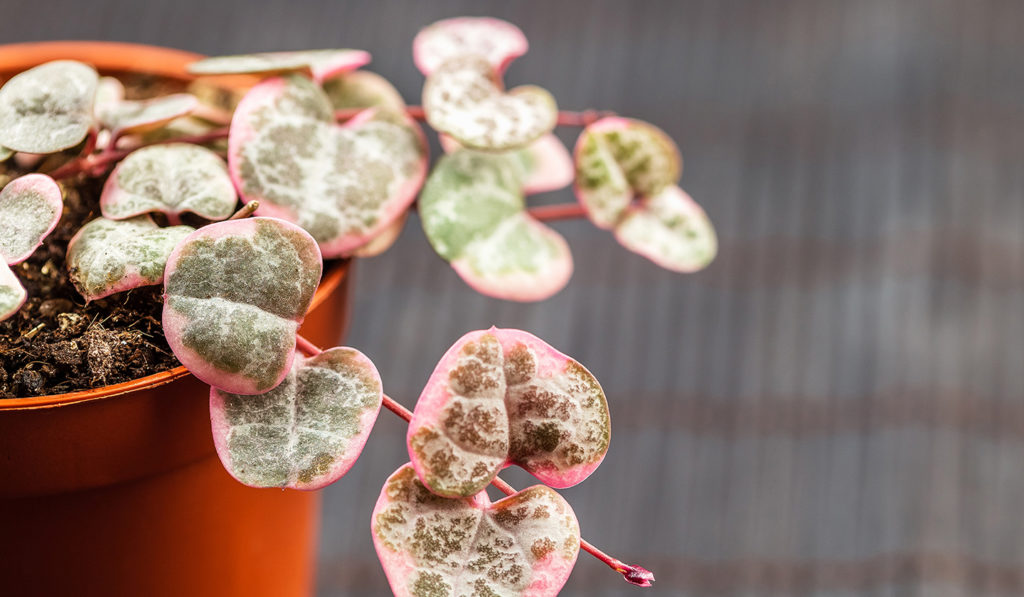

beyond the basics
-
soil + potting
String of heart plants are a member of the succulent family, so they need a porous, well-draining potting mix that doesn’t retain a lot of moisture because these beauties are prone to root rot. It’s recommended to use a succulent specific potting mix, like Miracle-Gro® Cactus, Palm & Succulent Potting Mix.
-
when to repot
String of hearts tend to be okay with staying slightly rootbound, so you don’t need to keep a strict schedule when repotting. A good rule of thumb is to repot about every 1 – 2 years. Use a pot that is a few inches bigger than its current pot and has a drainage hole.
-
propagation
Start by trimming your string of hearts just under a nodule. Place your cutting in moist soil and watch your new plant take root. This process will likely take about a month. Make sure the soil is kept moist during this growing period.
-
pest control
String of hearts are prone to root rot, so make sure your plant’s soil is drying out between watering. Other pests like aphids or mealybugs can be managed by using an insecticidal soap such as Ortho® Bug B Gon® ECO Insecticidal Soap.

troubleshooting
-
why are there big gaps between my leaves?
Not enough light. Move your string of hearts to a place where it can sit in ample indirect, bright light.
-
why are my leaves turning mushy and droopy?
Overwatering or root rot. Root rot is caused by overwatering. The easiest way to tell if it’s root rot or just overwatering is to give it a sniff. If your plant smells bad, it’s root rot. If it smells okay, just hold off on watering it for a little the soil dries out a bit.
-
why are my leaves turning brown?
Sunburn. It looks like your string of hearts is getting too much sun. These plants enjoy bright, but indirect light. Move your plant away from direct sunlight, but keep in a nice, bright room.
-
why are my plant’s leaves curling?
Underwatering. Thinning or curling leaves is a clear indicator of underwatering. Give your string of hearts a good soak and your plant should be happily re-hydrated.

money tree
aka pachira aquatica
Money Trees originated from Central and South America. The braided trunk of the tree isn’t naturally occurring. This feature is created by cultivators braiding young trees manually.
variations
Variations include Malabar Chestnut, Provision Tree, Guiana Chestnut and French Peanut.
light
avoid direct sunlight
Too much direct sunlight will cause the leaves to curl, yellow or burn.
water + feeding
water when dry
However, these plants can still do well without watering too frequently.
toxic
safe for humans and pets
Money Trees are even recommended for people with allergies or asthma.
location
adaptable
Although it’s recommended not to keep this plant in your bathroom because it’s believed this will “flush” good vibes away.
humidity
love it!
Money Trees appreciate a humid climate, with about 50% humidity.
size
small to medium
At home, your money tree could grow between 3 to 5 feet. In the wild, these trees can grow up to 60 feet tall.
pro tip
get a humidifier
Prevent yellowing and dying leaves by increasing the humidity in the plant’s environment.
fun fact
popular in feng shui
This plant usually sprouts 5 leaves on a stem, and 5 is a very important number in Feng Shui.


beyond the basics
-
soil + potting
Money Trees need a sandy, peat-moss based soil. Consider adding Miracle-Gro® Sphagnum Peat Moss to your plant’s soil. Don’t forget to use a pot with drainage!
-
when to repot
Money Trees usually need to be repotted every three years. The best time to repot is during the spring time, to promote growth. While you can cut back on some root growth, be sure not to take off more than 25% of the roots.
-
propagation
The best way to propagate your Money Tree is through a cutting. Take your 6 inch branch cutting, with several leaf nodes, and allow to root in water. Promptly transfer to a soil mixture with peat moss.
-
pest control
Money Trees are very attractive to aphids and mealybugs. You can use a gentle insecticide like Ortho® Bug B Gon® ECO Insecticide Ready-to-use to prevent these creepy crawlies from returning.

troubleshooting
-
why are my plant’s leaves drooping or turning yellow?
Watering issues. If your Money Tree’s leaves are drooping it could be as simple as inconsistent watering. Keep a schedule and check the soil’s moisture level to understand its needs. If the leaves are yellowing, it’s likely due to overwatering. It’s time to water when the top 2 to 4 inches of soil are dry.
-
why is my plant’s trunk spongey and soft?
Sounds like root rot. This happens when a fungus has attacked your plant’s roots and is a sign that you’ve been overwatering. Root rot can be fatal if it’s not caught early. The best chance you can give your Money Tree for survival is to repot immediately, removing as much old soil as possible.
-
what is this gross, sticky sap?
Guttation. This it totally normal! If the rest of your Money Tree looks healthy, there’s nothing to worry about. But… if you see little dark bumps on your plant, it could be a pest infestation.
-
why are my plant’s leaves curling?
Overwatering. Avoid excessive watering and finger test your plant’s soil when you’re about to water. Make sure you’re only watering when the first 2 to 4 inches of soil are dry.
-
why are my plant’s leaves falling?
Too much sunlight. Too much bright, direct sunlight can cause your Money Tree to drop leaves. Another common cause is if your Money Tree has recently moved to its new home. Dropping a few leaves as your plant adjusts to its new home is totally normal.

begonias
aka begoniaceae or begonia semperflorens
Begonias are popular houseplants and shaded garden beds. They have tropical/sub-tropical origins, and are known for their interesting, asymmetrical leaves. They add a bright punch of colour to a garden bed because of their bright, small flowers and variegated leaves.
variations
Wax begonias, Tuberous begonias, Cane begonias, Rhizomatous begonias, Rex begonias
light
filtered sun
Partial shade or filtered light
water + feeding
not too thirsty
Regular watering is important for healthy plants. The soil should remain moist at all times, but not too wet, as this can cause root rot. Water at the base of the plant to keep the foliage dry and prevent leaf spot and fungal diseases. For general growing purposes, apply a balanced water-soluble fertilizer once a month in the growing season. For plants grown strictly for their foliage, like angel wings, use a fertilizer that is higher in nitrogen.
toxic
somewhat
Although its most toxic parts are underground, it’s still best to keep begonias out of reach of your pets
size
mostly medium
Wax begonias: Wax begonias are typically grown as annuals, reaching 6 to 12 inches tall and wide. Tuberous begonias: They also have a larger growth habit than wax begonias, growing 12 to 18 inches tall as houseplants and up to 3 feet or more in outdoor containers. Cane begonias: Their size varies with growing conditions, from 6- to 12-inch houseplants to bushy plants up to 5 feet. Rhizomatous begonias: Sizes vary from just a few inches to large plants up to 3 feet tall and wide. Rex begonias: generally reach 12 to 18 inches tall and wide.
pro tip
happily root-bound?
Potted begonias prefer to be slightly root-bound rather than given too much room. Only repot when necessary, and preferably in spring before plants are moved outside and start actively growing. Select darker-leaved varieties or types with improved heat and sun tolerance for sunnier spots.
fun fact
cousins to pumpkins
The flower is related to pumpkins, squash, gourds, cucumbers and melons. Tuberous and wax begonias are edible and have a citrusy taste. The name Begonia honours Michel Begon, a former governor and amateur botanist.

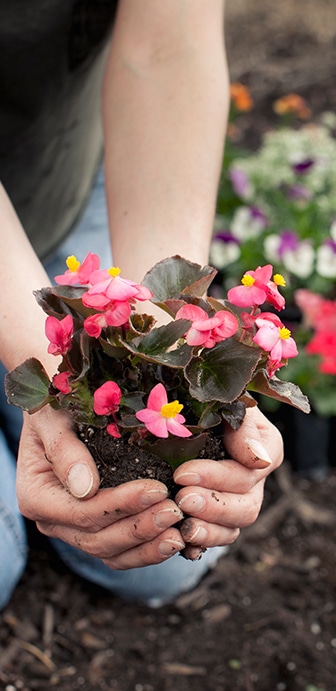
beyond the basics
-
soil & potting
All begonias like evenly moist, well-draining soil with some added organic matter. Plant wax begonia transplants 6 to 8 inches apart and others according to their mature size. Tubers can be started indoors by placing the tubers, hollow side up, 1 inch apart in a shallow tray with moist potting mix. Place the tray in a dark room and water just enough to keep the potting mix moist, but not soggy. Tubers should sprout in about 4 weeks and be moved to an area with bright light once the sprouts are about an inch tall. Only plant outdoors when there is no longer a threat of frost.
-
companion planting
Begonias look great planted together, or with cascading annuals like alyssum and lobelia. Try pairing them with Hosta or Bergenia in shade gardens.
-
blooms
When cutting back rhizomatous or wax types, make a clean, angled cut just above a leaf or flower node. To encourage fuller growth, younger plants (under 3 years) can be cut back to one or two nodes above the soil. Plants that are older should only be pruned lightly.
For cane begonias, pinch the tops when plants are about 6 inches tall to encourage bushier growth. Cut any canes that are much taller than the rest of the plant back to the soil. Remove old, brown, bare, or dead canes to the soil. Younger plants can be cut back by about 1/2.
Rex begonias require little pruning. Pinch back young plants to encourage fuller growth, and remove any leggy or bare stems as needed.
For all types, cut off spent begonia flowers about 1/2-inch below the flower to keep plants clean and healthy, as well as promote more blooms.
-
pest control
Susceptible to powdery mildew, mealybugs, spider mites, thrips, and whitefly. Stem rot and rhizome rot can be caused by overwatering and soggy soil.
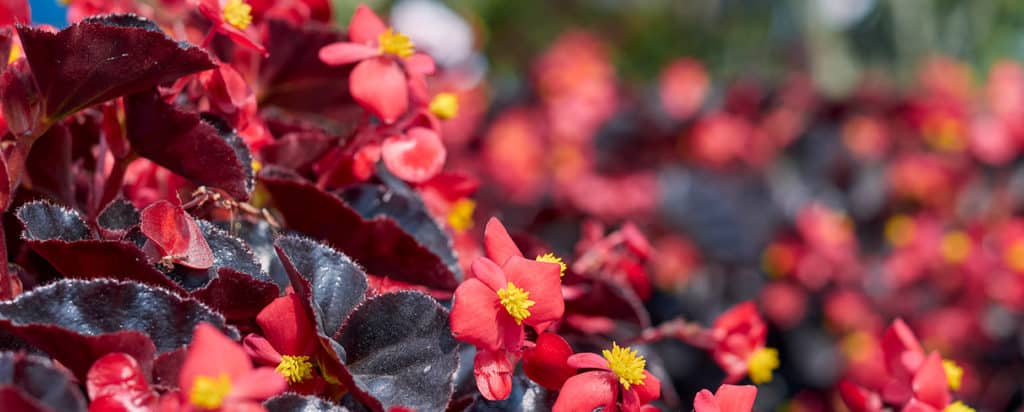
troubleshooting
-
spotted flowers?
Blooms may be damaged by improper watering. Your Begonia’s flowers are likely getting brown or transparent blotches where water drops have soaked through the petal. To prevent this, shield your petals when watering or be sure to hold the hose close to the soil versus above the plant.
-
white, powdery leaves?
This is mildew caused by a fungus that lives on the surface of your plant. Mildew will coat your Begonias in a white or gray powdery mold. Mildew will cause your Begonia’s leaves to discolour and drop off. To avoid this, be sure to allow adequate space between plants and collect any debris that falls around the base of the plant. Be sure not to overwater your plant!
-
dropping buds?
Could be caused by either over or under watering your plant, especially if they dry out completely between watering. Although tuberous begonias do best when the soil surface dries out slightly between waterings, try not to let them dry out completely. A sudden temperature change from hot to cold could also cause buds to drop off.
-
faded flowers?
Could be a result of a fungal disease that often results from poor ventilation, insufficient light or high humidity. Remove those faded flowers and be sure that your Begonias are planted in a well-ventilated area that receives adequate light, versus in a shady area. If the growing season is especially humid, gray mold may appear despite precautions. In such a case, destroy infected plant parts, and spray buds and blooms with flowable sulfur fungicide every 3 to 5 days.

begonias
aka begoniaceae or begonia semperflorens
Begonias are popular houseplants and shaded garden beds. They have tropical/sub-tropical origins, and are known for their interesting, asymmetrical leaves. They add a bright punch of colour to a garden bed because of their bright, small flowers and variegated leaves.
variations
Wax begonias, Tuberous begonias, Cane begonias, Rhizomatous begonias, Rex begonias
light
filtered sun
Partial shade or filtered light
water + feeding
not too thirsty
Regular watering is important for healthy plants. The soil should remain moist at all times, but not too wet, as this can cause root rot. Water at the base of the plant to keep the foliage dry and prevent leaf spot and fungal diseases. For general growing purposes, apply a balanced water-soluble fertilizer once a month in the growing season. For plants grown strictly for their foliage, like angel wings, use a fertilizer that is higher in nitrogen.
toxic
somewhat
Although its most toxic parts are underground, it’s still best to keep begonias out of reach of your pets
size
mostly medium
Wax begonias: Wax begonias are typically grown as annuals, reaching 6 to 12 inches tall and wide. Tuberous begonias: They also have a larger growth habit than wax begonias, growing 12 to 18 inches tall as houseplants and up to 3 feet or more in outdoor containers. Cane begonias: Their size varies with growing conditions, from 6- to 12-inch houseplants to bushy plants up to 5 feet. Rhizomatous begonias: Sizes vary from just a few inches to large plants up to 3 feet tall and wide. Rex begonias: generally reach 12 to 18 inches tall and wide.
pro tip
happily root-bound?
Potted begonias prefer to be slightly root-bound rather than given too much room. Only repot when necessary, and preferably in spring before plants are moved outside and start actively growing. Select darker-leaved varieties or types with improved heat and sun tolerance for sunnier spots.
fun fact
cousins to pumpkins
The flower is related to pumpkins, squash, gourds, cucumbers and melons. Tuberous and wax begonias are edible and have a citrusy taste. The name Begonia honours Michel Begon, a former governor and amateur botanist.


beyond the basics
-
soil & potting
All begonias like evenly moist, well-draining soil with some added organic matter. Plant wax begonia transplants 6 to 8 inches apart and others according to their mature size. Tubers can be started indoors by placing the tubers, hollow side up, 1 inch apart in a shallow tray with moist potting mix. Place the tray in a dark room and water just enough to keep the potting mix moist, but not soggy. Tubers should sprout in about 4 weeks and be moved to an area with bright light once the sprouts are about an inch tall. Only plant outdoors when there is no longer a threat of frost.
-
companion planting
Begonias look great planted together, or with cascading annuals like alyssum and lobelia. Try pairing them with Hosta or Bergenia in shade gardens.
-
blooms
When cutting back rhizomatous or wax types, make a clean, angled cut just above a leaf or flower node. To encourage fuller growth, younger plants (under 3 years) can be cut back to one or two nodes above the soil. Plants that are older should only be pruned lightly.
For cane begonias, pinch the tops when plants are about 6 inches tall to encourage bushier growth. Cut any canes that are much taller than the rest of the plant back to the soil. Remove old, brown, bare, or dead canes to the soil. Younger plants can be cut back by about 1/2.
Rex begonias require little pruning. Pinch back young plants to encourage fuller growth, and remove any leggy or bare stems as needed.
For all types, cut off spent begonia flowers about 1/2-inch below the flower to keep plants clean and healthy, as well as promote more blooms.
-
pest control
Susceptible to powdery mildew, mealybugs, spider mites, thrips, and whitefly. Stem rot and rhizome rot can be caused by overwatering and soggy soil.

troubleshooting
-
spotted flowers?
Blooms may be damaged by improper watering. Your Begonia’s flowers are likely getting brown or transparent blotches where water drops have soaked through the petal. To prevent this, shield your petals when watering or be sure to hold the hose close to the soil versus above the plant.
-
white, powdery leaves?
This is mildew caused by a fungus that lives on the surface of your plant. Mildew will coat your Begonias in a white or gray powdery mold. Mildew will cause your Begonia’s leaves to discolour and drop off. To avoid this, be sure to allow adequate space between plants and collect any debris that falls around the base of the plant. Be sure not to overwater your plant!
-
dropping buds?
Could be caused by either over or under watering your plant, especially if they dry out completely between watering. Although tuberous begonias do best when the soil surface dries out slightly between waterings, try not to let them dry out completely. A sudden temperature change from hot to cold could also cause buds to drop off.
-
faded flowers?
Could be a result of a fungal disease that often results from poor ventilation, insufficient light or high humidity. Remove those faded flowers and be sure that your Begonias are planted in a well-ventilated area that receives adequate light, versus in a shady area. If the growing season is especially humid, gray mold may appear despite precautions. In such a case, destroy infected plant parts, and spray buds and blooms with flowable sulfur fungicide every 3 to 5 days.

begonias
aka begoniaceae or begonia semperflorens
Begonias are popular houseplants and shaded garden beds. They have tropical/sub-tropical origins, and are known for their interesting, asymmetrical leaves. They add a bright punch of colour to a garden bed because of their bright, small flowers and variegated leaves.
variations
Wax begonias, Tuberous begonias, Cane begonias, Rhizomatous begonias, Rex begonias
light
filtered sun
Partial shade or filtered light
water + feeding
not too thirsty
Regular watering is important for healthy plants. The soil should remain moist at all times, but not too wet, as this can cause root rot. Water at the base of the plant to keep the foliage dry and prevent leaf spot and fungal diseases. For general growing purposes, apply a balanced water-soluble fertilizer once a month in the growing season. For plants grown strictly for their foliage, like angel wings, use a fertilizer that is higher in nitrogen.
toxic
somewhat
Although its most toxic parts are underground, it’s still best to keep begonias out of reach of your pets
size
mostly medium
Wax begonias: Wax begonias are typically grown as annuals, reaching 6 to 12 inches tall and wide. Tuberous begonias: They also have a larger growth habit than wax begonias, growing 12 to 18 inches tall as houseplants and up to 3 feet or more in outdoor containers. Cane begonias: Their size varies with growing conditions, from 6- to 12-inch houseplants to bushy plants up to 5 feet. Rhizomatous begonias: Sizes vary from just a few inches to large plants up to 3 feet tall and wide. Rex begonias: generally reach 12 to 18 inches tall and wide.
pro tip
happily root-bound?
Potted begonias prefer to be slightly root-bound rather than given too much room. Only repot when necessary, and preferably in spring before plants are moved outside and start actively growing. Select darker-leaved varieties or types with improved heat and sun tolerance for sunnier spots.
fun fact
cousins to pumpkins
The flower is related to pumpkins, squash, gourds, cucumbers and melons. Tuberous and wax begonias are edible and have a citrusy taste. The name Begonia honours Michel Begon, a former governor and amateur botanist.
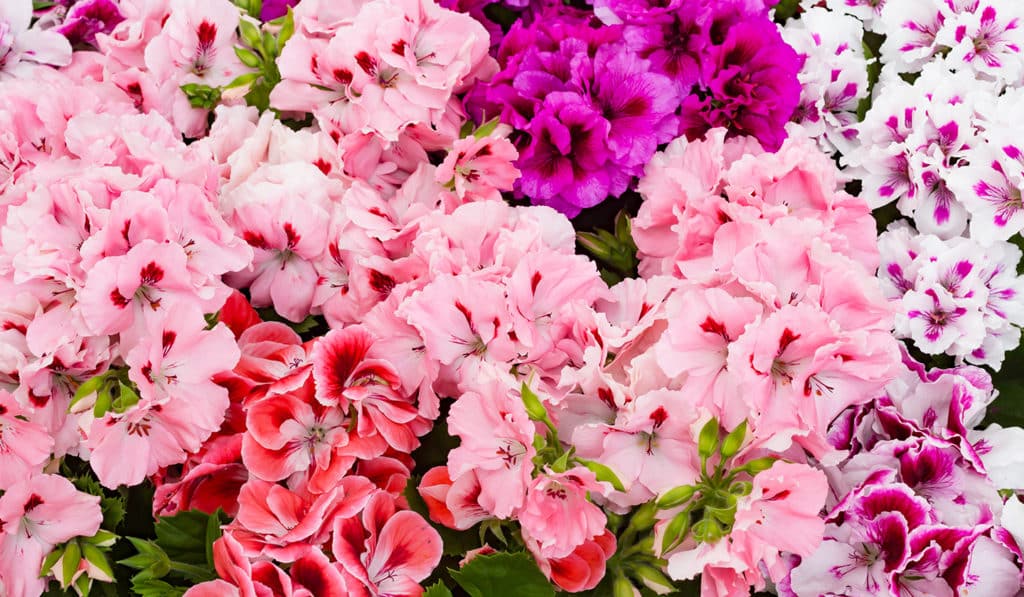

beyond the basics
-
soil & potting
All begonias like evenly moist, well-draining soil with some added organic matter. Plant wax begonia transplants 6 to 8 inches apart and others according to their mature size. Tubers can be started indoors by placing the tubers, hollow side up, 1 inch apart in a shallow tray with moist potting mix. Place the tray in a dark room and water just enough to keep the potting mix moist, but not soggy. Tubers should sprout in about 4 weeks and be moved to an area with bright light once the sprouts are about an inch tall. Only plant outdoors when there is no longer a threat of frost.
-
companion planting
Begonias look great planted together, or with cascading annuals like alyssum and lobelia. Try pairing them with Hosta or Bergenia in shade gardens.
-
blooms
When cutting back rhizomatous or wax types, make a clean, angled cut just above a leaf or flower node. To encourage fuller growth, younger plants (under 3 years) can be cut back to one or two nodes above the soil. Plants that are older should only be pruned lightly.
For cane begonias, pinch the tops when plants are about 6 inches tall to encourage bushier growth. Cut any canes that are much taller than the rest of the plant back to the soil. Remove old, brown, bare, or dead canes to the soil. Younger plants can be cut back by about 1/2.
Rex begonias require little pruning. Pinch back young plants to encourage fuller growth, and remove any leggy or bare stems as needed.
For all types, cut off spent begonia flowers about 1/2-inch below the flower to keep plants clean and healthy, as well as promote more blooms.
-
pest control
Susceptible to powdery mildew, mealybugs, spider mites, thrips, and whitefly. Stem rot and rhizome rot can be caused by overwatering and soggy soil.

troubleshooting
-
spotted flowers?
Blooms may be damaged by improper watering. Your Begonia’s flowers are likely getting brown or transparent blotches where water drops have soaked through the petal. To prevent this, shield your petals when watering or be sure to hold the hose close to the soil versus above the plant.
-
white, powdery leaves?
This is mildew caused by a fungus that lives on the surface of your plant. Mildew will coat your Begonias in a white or gray powdery mold. Mildew will cause your Begonia’s leaves to discolour and drop off. To avoid this, be sure to allow adequate space between plants and collect any debris that falls around the base of the plant. Be sure not to overwater your plant!
-
dropping buds?
Could be caused by either over or under watering your plant, especially if they dry out completely between watering. Although tuberous begonias do best when the soil surface dries out slightly between waterings, try not to let them dry out completely. A sudden temperature change from hot to cold could also cause buds to drop off.
-
faded flowers?
Could be a result of a fungal disease that often results from poor ventilation, insufficient light or high humidity. Remove those faded flowers and be sure that your Begonias are planted in a well-ventilated area that receives adequate light, versus in a shady area. If the growing season is especially humid, gray mold may appear despite precautions. In such a case, destroy infected plant parts, and spray buds and blooms with flowable sulfur fungicide every 3 to 5 days.

begonias
aka begoniaceae or begonia semperflorens
Begonias are popular houseplants and shaded garden beds. They have tropical/sub-tropical origins, and are known for their interesting, asymmetrical leaves. They add a bright punch of colour to a garden bed because of their bright, small flowers and variegated leaves.
variations
Wax begonias, Tuberous begonias, Cane begonias, Rhizomatous begonias, Rex begonias
light
filtered sun
Partial shade or filtered light
water + feeding
not too thirsty
Regular watering is important for healthy plants. The soil should remain moist at all times, but not too wet, as this can cause root rot. Water at the base of the plant to keep the foliage dry and prevent leaf spot and fungal diseases. For general growing purposes, apply a balanced water-soluble fertilizer once a month in the growing season. For plants grown strictly for their foliage, like angel wings, use a fertilizer that is higher in nitrogen.
toxic
somewhat
Although its most toxic parts are underground, it’s still best to keep begonias out of reach of your pets
size
mostly medium
Wax begonias: Wax begonias are typically grown as annuals, reaching 6 to 12 inches tall and wide. Tuberous begonias: They also have a larger growth habit than wax begonias, growing 12 to 18 inches tall as houseplants and up to 3 feet or more in outdoor containers. Cane begonias: Their size varies with growing conditions, from 6- to 12-inch houseplants to bushy plants up to 5 feet. Rhizomatous begonias: Sizes vary from just a few inches to large plants up to 3 feet tall and wide. Rex begonias: generally reach 12 to 18 inches tall and wide.
pro tip
happily root-bound?
Potted begonias prefer to be slightly root-bound rather than given too much room. Only repot when necessary, and preferably in spring before plants are moved outside and start actively growing. Select darker-leaved varieties or types with improved heat and sun tolerance for sunnier spots.
fun fact
cousins to pumpkins
The flower is related to pumpkins, squash, gourds, cucumbers and melons. Tuberous and wax begonias are edible and have a citrusy taste. The name Begonia honours Michel Begon, a former governor and amateur botanist.


beyond the basics
-
soil & potting
All begonias like evenly moist, well-draining soil with some added organic matter. Plant wax begonia transplants 6 to 8 inches apart and others according to their mature size. Tubers can be started indoors by placing the tubers, hollow side up, 1 inch apart in a shallow tray with moist potting mix. Place the tray in a dark room and water just enough to keep the potting mix moist, but not soggy. Tubers should sprout in about 4 weeks and be moved to an area with bright light once the sprouts are about an inch tall. Only plant outdoors when there is no longer a threat of frost.
-
companion planting
Begonias look great planted together, or with cascading annuals like alyssum and lobelia. Try pairing them with Hosta or Bergenia in shade gardens.
-
blooms
When cutting back rhizomatous or wax types, make a clean, angled cut just above a leaf or flower node. To encourage fuller growth, younger plants (under 3 years) can be cut back to one or two nodes above the soil. Plants that are older should only be pruned lightly.
For cane begonias, pinch the tops when plants are about 6 inches tall to encourage bushier growth. Cut any canes that are much taller than the rest of the plant back to the soil. Remove old, brown, bare, or dead canes to the soil. Younger plants can be cut back by about 1/2.
Rex begonias require little pruning. Pinch back young plants to encourage fuller growth, and remove any leggy or bare stems as needed.
For all types, cut off spent begonia flowers about 1/2-inch below the flower to keep plants clean and healthy, as well as promote more blooms.
-
pest control
Susceptible to powdery mildew, mealybugs, spider mites, thrips, and whitefly. Stem rot and rhizome rot can be caused by overwatering and soggy soil.
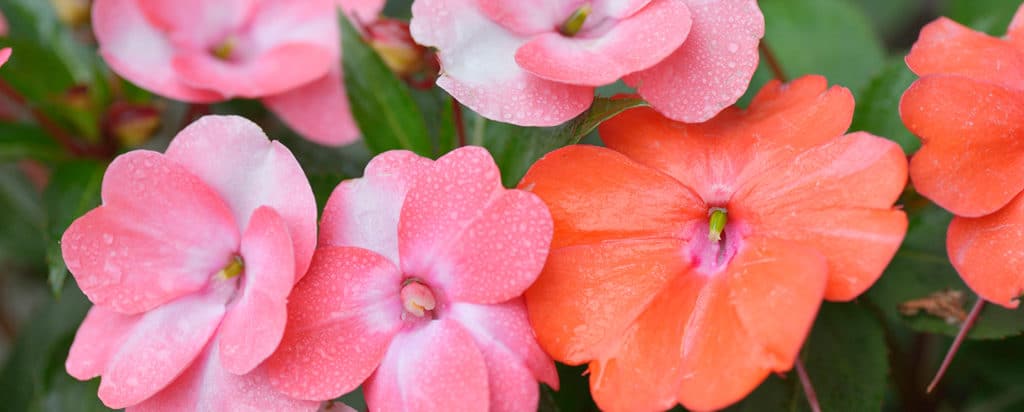
troubleshooting
-
spotted flowers?
Blooms may be damaged by improper watering. Your Begonia’s flowers are likely getting brown or transparent blotches where water drops have soaked through the petal. To prevent this, shield your petals when watering or be sure to hold the hose close to the soil versus above the plant.
-
white, powdery leaves?
This is mildew caused by a fungus that lives on the surface of your plant. Mildew will coat your Begonias in a white or gray powdery mold. Mildew will cause your Begonia’s leaves to discolour and drop off. To avoid this, be sure to allow adequate space between plants and collect any debris that falls around the base of the plant. Be sure not to overwater your plant!
-
dropping buds?
Could be caused by either over or under watering your plant, especially if they dry out completely between watering. Although tuberous begonias do best when the soil surface dries out slightly between waterings, try not to let them dry out completely. A sudden temperature change from hot to cold could also cause buds to drop off.
-
faded flowers?
Could be a result of a fungal disease that often results from poor ventilation, insufficient light or high humidity. Remove those faded flowers and be sure that your Begonias are planted in a well-ventilated area that receives adequate light, versus in a shady area. If the growing season is especially humid, gray mold may appear despite precautions. In such a case, destroy infected plant parts, and spray buds and blooms with flowable sulfur fungicide every 3 to 5 days.

begonias
aka begoniaceae or begonia semperflorens
Begonias are popular houseplants and shaded garden beds. They have tropical/sub-tropical origins, and are known for their interesting, asymmetrical leaves. They add a bright punch of colour to a garden bed because of their bright, small flowers and variegated leaves.
variations
Wax begonias, Tuberous begonias, Cane begonias, Rhizomatous begonias, Rex begonias
light
filtered sun
Partial shade or filtered light
water + feeding
not too thirsty
Regular watering is important for healthy plants. The soil should remain moist at all times, but not too wet, as this can cause root rot. Water at the base of the plant to keep the foliage dry and prevent leaf spot and fungal diseases. For general growing purposes, apply a balanced water-soluble fertilizer once a month in the growing season. For plants grown strictly for their foliage, like angel wings, use a fertilizer that is higher in nitrogen.
toxic
somewhat
Although its most toxic parts are underground, it’s still best to keep begonias out of reach of your pets
size
mostly medium
Wax begonias: Wax begonias are typically grown as annuals, reaching 6 to 12 inches tall and wide. Tuberous begonias: They also have a larger growth habit than wax begonias, growing 12 to 18 inches tall as houseplants and up to 3 feet or more in outdoor containers. Cane begonias: Their size varies with growing conditions, from 6- to 12-inch houseplants to bushy plants up to 5 feet. Rhizomatous begonias: Sizes vary from just a few inches to large plants up to 3 feet tall and wide. Rex begonias: generally reach 12 to 18 inches tall and wide.
pro tip
happily root-bound?
Potted begonias prefer to be slightly root-bound rather than given too much room. Only repot when necessary, and preferably in spring before plants are moved outside and start actively growing. Select darker-leaved varieties or types with improved heat and sun tolerance for sunnier spots.
fun fact
cousins to pumpkins
The flower is related to pumpkins, squash, gourds, cucumbers and melons. Tuberous and wax begonias are edible and have a citrusy taste. The name Begonia honours Michel Begon, a former governor and amateur botanist.


beyond the basics
-
soil & potting
All begonias like evenly moist, well-draining soil with some added organic matter. Plant wax begonia transplants 6 to 8 inches apart and others according to their mature size. Tubers can be started indoors by placing the tubers, hollow side up, 1 inch apart in a shallow tray with moist potting mix. Place the tray in a dark room and water just enough to keep the potting mix moist, but not soggy. Tubers should sprout in about 4 weeks and be moved to an area with bright light once the sprouts are about an inch tall. Only plant outdoors when there is no longer a threat of frost.
-
companion planting
Begonias look great planted together, or with cascading annuals like alyssum and lobelia. Try pairing them with Hosta or Bergenia in shade gardens.
-
blooms
When cutting back rhizomatous or wax types, make a clean, angled cut just above a leaf or flower node. To encourage fuller growth, younger plants (under 3 years) can be cut back to one or two nodes above the soil. Plants that are older should only be pruned lightly.
For cane begonias, pinch the tops when plants are about 6 inches tall to encourage bushier growth. Cut any canes that are much taller than the rest of the plant back to the soil. Remove old, brown, bare, or dead canes to the soil. Younger plants can be cut back by about 1/2.
Rex begonias require little pruning. Pinch back young plants to encourage fuller growth, and remove any leggy or bare stems as needed.
For all types, cut off spent begonia flowers about 1/2-inch below the flower to keep plants clean and healthy, as well as promote more blooms.
-
pest control
Susceptible to powdery mildew, mealybugs, spider mites, thrips, and whitefly. Stem rot and rhizome rot can be caused by overwatering and soggy soil.

troubleshooting
-
spotted flowers?
Blooms may be damaged by improper watering. Your Begonia’s flowers are likely getting brown or transparent blotches where water drops have soaked through the petal. To prevent this, shield your petals when watering or be sure to hold the hose close to the soil versus above the plant.
-
white, powdery leaves?
This is mildew caused by a fungus that lives on the surface of your plant. Mildew will coat your Begonias in a white or gray powdery mold. Mildew will cause your Begonia’s leaves to discolour and drop off. To avoid this, be sure to allow adequate space between plants and collect any debris that falls around the base of the plant. Be sure not to overwater your plant!
-
dropping buds?
Could be caused by either over or under watering your plant, especially if they dry out completely between watering. Although tuberous begonias do best when the soil surface dries out slightly between waterings, try not to let them dry out completely. A sudden temperature change from hot to cold could also cause buds to drop off.
-
faded flowers?
Could be a result of a fungal disease that often results from poor ventilation, insufficient light or high humidity. Remove those faded flowers and be sure that your Begonias are planted in a well-ventilated area that receives adequate light, versus in a shady area. If the growing season is especially humid, gray mold may appear despite precautions. In such a case, destroy infected plant parts, and spray buds and blooms with flowable sulfur fungicide every 3 to 5 days.

begonias
aka begoniaceae or begonia semperflorens
Begonias are popular houseplants and shaded garden beds. They have tropical/sub-tropical origins, and are known for their interesting, asymmetrical leaves. They add a bright punch of colour to a garden bed because of their bright, small flowers and variegated leaves.
variations
Wax begonias, Tuberous begonias, Cane begonias, Rhizomatous begonias, Rex begonias
light
filtered sun
Partial shade or filtered light
water + feeding
not too thirsty
Regular watering is important for healthy plants. The soil should remain moist at all times, but not too wet, as this can cause root rot. Water at the base of the plant to keep the foliage dry and prevent leaf spot and fungal diseases. For general growing purposes, apply a balanced water-soluble fertilizer once a month in the growing season. For plants grown strictly for their foliage, like angel wings, use a fertilizer that is higher in nitrogen.
toxic
somewhat
Although its most toxic parts are underground, it’s still best to keep begonias out of reach of your pets
size
mostly medium
Wax begonias: Wax begonias are typically grown as annuals, reaching 6 to 12 inches tall and wide. Tuberous begonias: They also have a larger growth habit than wax begonias, growing 12 to 18 inches tall as houseplants and up to 3 feet or more in outdoor containers. Cane begonias: Their size varies with growing conditions, from 6- to 12-inch houseplants to bushy plants up to 5 feet. Rhizomatous begonias: Sizes vary from just a few inches to large plants up to 3 feet tall and wide. Rex begonias: generally reach 12 to 18 inches tall and wide.
pro tip
happily root-bound?
Potted begonias prefer to be slightly root-bound rather than given too much room. Only repot when necessary, and preferably in spring before plants are moved outside and start actively growing. Select darker-leaved varieties or types with improved heat and sun tolerance for sunnier spots.
fun fact
cousins to pumpkins
The flower is related to pumpkins, squash, gourds, cucumbers and melons. Tuberous and wax begonias are edible and have a citrusy taste. The name Begonia honours Michel Begon, a former governor and amateur botanist.


beyond the basics
-
soil & potting
All begonias like evenly moist, well-draining soil with some added organic matter. Plant wax begonia transplants 6 to 8 inches apart and others according to their mature size. Tubers can be started indoors by placing the tubers, hollow side up, 1 inch apart in a shallow tray with moist potting mix. Place the tray in a dark room and water just enough to keep the potting mix moist, but not soggy. Tubers should sprout in about 4 weeks and be moved to an area with bright light once the sprouts are about an inch tall. Only plant outdoors when there is no longer a threat of frost.
-
companion planting
Begonias look great planted together, or with cascading annuals like alyssum and lobelia. Try pairing them with Hosta or Bergenia in shade gardens.
-
blooms
When cutting back rhizomatous or wax types, make a clean, angled cut just above a leaf or flower node. To encourage fuller growth, younger plants (under 3 years) can be cut back to one or two nodes above the soil. Plants that are older should only be pruned lightly.
For cane begonias, pinch the tops when plants are about 6 inches tall to encourage bushier growth. Cut any canes that are much taller than the rest of the plant back to the soil. Remove old, brown, bare, or dead canes to the soil. Younger plants can be cut back by about 1/2.
Rex begonias require little pruning. Pinch back young plants to encourage fuller growth, and remove any leggy or bare stems as needed.
For all types, cut off spent begonia flowers about 1/2-inch below the flower to keep plants clean and healthy, as well as promote more blooms.
-
pest control
Susceptible to powdery mildew, mealybugs, spider mites, thrips, and whitefly. Stem rot and rhizome rot can be caused by overwatering and soggy soil.

troubleshooting
-
spotted flowers?
Blooms may be damaged by improper watering. Your Begonia’s flowers are likely getting brown or transparent blotches where water drops have soaked through the petal. To prevent this, shield your petals when watering or be sure to hold the hose close to the soil versus above the plant.
-
white, powdery leaves?
This is mildew caused by a fungus that lives on the surface of your plant. Mildew will coat your Begonias in a white or gray powdery mold. Mildew will cause your Begonia’s leaves to discolour and drop off. To avoid this, be sure to allow adequate space between plants and collect any debris that falls around the base of the plant. Be sure not to overwater your plant!
-
dropping buds?
Could be caused by either over or under watering your plant, especially if they dry out completely between watering. Although tuberous begonias do best when the soil surface dries out slightly between waterings, try not to let them dry out completely. A sudden temperature change from hot to cold could also cause buds to drop off.
-
faded flowers?
Could be a result of a fungal disease that often results from poor ventilation, insufficient light or high humidity. Remove those faded flowers and be sure that your Begonias are planted in a well-ventilated area that receives adequate light, versus in a shady area. If the growing season is especially humid, gray mold may appear despite precautions. In such a case, destroy infected plant parts, and spray buds and blooms with flowable sulfur fungicide every 3 to 5 days.

begonias
aka begoniaceae or begonia semperflorens
Begonias are popular houseplants and shaded garden beds. They have tropical/sub-tropical origins, and are known for their interesting, asymmetrical leaves. They add a bright punch of colour to a garden bed because of their bright, small flowers and variegated leaves.
variations
Wax begonias, Tuberous begonias, Cane begonias, Rhizomatous begonias, Rex begonias
light
filtered sun
Partial shade or filtered light
water + feeding
not too thirsty
Regular watering is important for healthy plants. The soil should remain moist at all times, but not too wet, as this can cause root rot. Water at the base of the plant to keep the foliage dry and prevent leaf spot and fungal diseases. For general growing purposes, apply a balanced water-soluble fertilizer once a month in the growing season. For plants grown strictly for their foliage, like angel wings, use a fertilizer that is higher in nitrogen.
toxic
somewhat
Although its most toxic parts are underground, it’s still best to keep begonias out of reach of your pets
size
mostly medium
Wax begonias: Wax begonias are typically grown as annuals, reaching 6 to 12 inches tall and wide. Tuberous begonias: They also have a larger growth habit than wax begonias, growing 12 to 18 inches tall as houseplants and up to 3 feet or more in outdoor containers. Cane begonias: Their size varies with growing conditions, from 6- to 12-inch houseplants to bushy plants up to 5 feet. Rhizomatous begonias: Sizes vary from just a few inches to large plants up to 3 feet tall and wide. Rex begonias: generally reach 12 to 18 inches tall and wide.
pro tip
happily root-bound?
Potted begonias prefer to be slightly root-bound rather than given too much room. Only repot when necessary, and preferably in spring before plants are moved outside and start actively growing. Select darker-leaved varieties or types with improved heat and sun tolerance for sunnier spots.
fun fact
cousins to pumpkins
The flower is related to pumpkins, squash, gourds, cucumbers and melons. Tuberous and wax begonias are edible and have a citrusy taste. The name Begonia honours Michel Begon, a former governor and amateur botanist.


beyond the basics
-
soil & potting
ZZ prefers a light, well-draining potting soil like Miracle-Gro Cactus, Palm and Succulent Potting Mix. Or, use regular potting soil and add some potting sand or perlite. Ensure the pot has good drainage and avoid standing water. Empty drainage trays if you see water collecting.
-
when to repot
In the right light, ZZ grows quickly. Amazingly, they actually enjoy being a little rootbound, so you don’t need to repot as often as other plants. Repot every 3 to 4 years in the Spring, especially with younger plants. Increase pot by 2 inches every time. If you want to slow down growth, do some root trimming. In later years you can replace the top couple inches of soil instead of completely repotting.
-
propagation
Even propagation is easy with ZZ. Dig up the thick root ball and cut it in half. You can technically propagate your ZZ via stem and leaf cuttings, but it’s so much harder than cutting the root ball that we don’t recommend it.
-
pest control
Can get mealybugs and spider mites. When you’re dusting those glossy leaves, inspect the undersides. Check out our Pest control section in Plant 101 for how to identify and deal with pests on your plant!

troubleshooting
-
why the yellowing leaves?
Overwatering. By far the most common problem with ZZ. Especially in Winter when it doesn’t need (or want) much water at all. If the plant has been sitting in water, it may have root rot. This problem is no big deal if you catch it early. First, stop watering! Let’s dry out that soil. Check your pot’s drainage. Does it have a hole that allows excess water to escape? Help things dry by poking holes in the soil. This will get oxygen to the roots. You can also put the pot (with drainage holes) in a tray that’s lined with a layer of dry soil. It acts like a sponge to draw out extra moisture. Now, let’s check for root rot. Dig down and cut out any that look affected. If things are really bad, consider repotting entirely with new soil. Moving forward, allow ZZ’s soil to dry between watering. The top couple inches should be dry to the touch. For more information check out our Plant 101 section.
-
why do I have many dropping leaves?
Probably stressed. ZZ is tough but not invincible. If you’ve moved it recently that may have stressed it out. Did you just bring it home from the nursery? That’s a big change. Leaf drop is most common when ZZ was in shade and suddenly put in full sun. Ease you plant to new area when you can. If you haven’t moved it recently, check for wet or totally bone-dry soil. See above for proper watering regimen.
-
what’s with the brown patches on leaves?
Sunburn. It can handle some direct sun, but long Summer exposure can burn even the mighty ZZ. Try moving your plant somewhere that’s still bright, but with indirect light.
-
why isn’t it growing?
Not enough light. ZZ survives well in low light, but it takes bright light for ZZ to thrive and grow. If you’re happy with the size, keep it shady. If you want to see ZZ’s impressive growth in action, move it somewhere with plenty of bright and mostly indirect light. Make this change gradually if you can. Increase your watering (but just a bit) to suit the increased light.
-
why the soft or drooping stems?
Again, overwatering. This is stem rot, spreading up from root rot. Remove all those mushy stems or trim away anything that looks like rot. Now let’s dry the soil and check the roots. Check your pot’s drainage. Does it have a hole that allows excess water to escape? Help things dry by poking holes in the soil. This will get oxygen to the roots. You can also put the pot (with drainage holes) in a tray that’s lined with a layer of dry soil. It acts like a sponge to draw out extra moisture. Now, let’s check for root rot. Dig down and cut out any that look affected. If things are really bad, consider repotting entirely with new soil. Moving forward, allow ZZ’s soil to dry between watering. The top couple inches should be dry to the touch. For more information check out our Plant 101 section.

begonias
aka begoniaceae or begonia semperflorens
Begonias are popular houseplants and shaded garden beds. They have tropical/sub-tropical origins, and are known for their interesting, asymmetrical leaves. They add a bright punch of colour to a garden bed because of their bright, small flowers and variegated leaves.
variations
Wax begonias, Tuberous begonias, Cane begonias, Rhizomatous begonias, Rex begonias
light
filtered sun
Partial shade or filtered light
water + feeding
not too thirsty
Regular watering is important for healthy plants. The soil should remain moist at all times, but not too wet, as this can cause root rot. Water at the base of the plant to keep the foliage dry and prevent leaf spot and fungal diseases. For general growing purposes, apply a balanced water-soluble fertilizer once a month in the growing season. For plants grown strictly for their foliage, like angel wings, use a fertilizer that is higher in nitrogen.
toxic
somewhat
Although its most toxic parts are underground, it’s still best to keep begonias out of reach of your pets
size
mostly medium
Wax begonias: Wax begonias are typically grown as annuals, reaching 6 to 12 inches tall and wide. Tuberous begonias: They also have a larger growth habit than wax begonias, growing 12 to 18 inches tall as houseplants and up to 3 feet or more in outdoor containers. Cane begonias: Their size varies with growing conditions, from 6- to 12-inch houseplants to bushy plants up to 5 feet. Rhizomatous begonias: Sizes vary from just a few inches to large plants up to 3 feet tall and wide. Rex begonias: generally reach 12 to 18 inches tall and wide.
pro tip
happily root-bound?
Potted begonias prefer to be slightly root-bound rather than given too much room. Only repot when necessary, and preferably in spring before plants are moved outside and start actively growing. Select darker-leaved varieties or types with improved heat and sun tolerance for sunnier spots.
fun fact
cousins to pumpkins
The flower is related to pumpkins, squash, gourds, cucumbers and melons. Tuberous and wax begonias are edible and have a citrusy taste. The name Begonia honours Michel Begon, a former governor and amateur botanist.

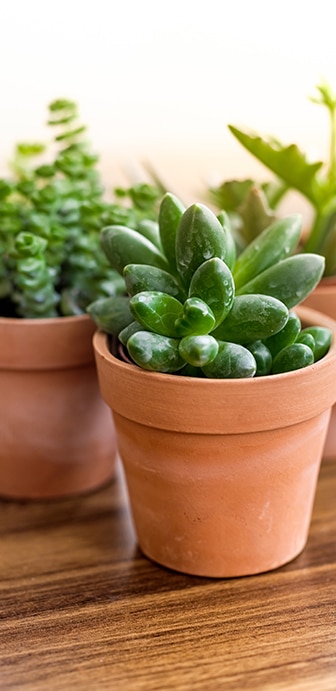
beyond the basics
-
soil & potting
These desert dwellers prefer a light, well-draining potting soil like Miracle-Gro Cactus, Palm and Succulent Potting Mix. Or, use regular potting soil and add some potting sand or perlite. A layer of sand on the top will help prevent rot. Ensure the pot has good drainage and aloe should never sit in water. Empty drainage trays if you see water collecting.
-
when to repot
Repot every 1 to 2 years in the Spring, especially with younger plants. Increase pot diameter by 2 inches every time. Want them to stay cute and little? You can stunt the growth by root trimming. In later years you can replace the top couple inches of soil instead of completely repotting.
-
propagation
Making new succulent plant babies is easy. In fact many propagate on their own. You will notice little mini versions starting grow. These “pups” can be gently separated potted as a new plant. If you’re not getting pups, remove a leaf, let it dry for a couple of days and place it on some moist soil. It should sprout roots, and voila! You have an ultra mini plant.
-
pest control
Succulents don’t typically suffer from pests, but they can sometimes get bugs. Gnats are most likely. Inspect those juicy little leaves regularly. Check out our Pest control section in Plant 101 for how to identify and deal with pests on your plant!

troubleshooting
-
why are the eaves turning brown, red or reddish brown?
A couple of possibilities. Maybe too much direct summer sun. Or possibly overwatering or root damage. First, moving your plant to a still-bright but less sun-blasted spot. Reduce the watering and follow our watering instructions above. If your succulent buddy still doesn’t bounce back, check for root damage.
-
what’s causing these dark spots? brown or mushy leaves?
Almost certainly too much water. This problem is no big deal if you catch it early. First, stop watering! Let’s dry out that soil. Check your pot’s drainage. Does it have a hole that allows excess water to escape? Help things dry by poking holes in the soil. This will get oxygen to the roots. You can also put the pot (with drainage holes) in a tray that’s lined with a layer of dry soil. It acts like a sponge to draw out extra moisture. Now, let’s check for root rot. Dig down and cut out any that look affected. If things are really bad, consider repotting entirely with new soil. Moving forward, water only when the soil is totally dry and make sure you water the soil, not the leaves. Water can collect between the leaves at its base, and start to rot. A thin layer of sand on top of the soil can reduce pooling water up top.
For more information check out our Plant 101 section.
-
pale or yellowing leaves?
Not enough light and/or overwatering. If the whole plant has yellowed or gone pale, it definitely needs more light. Move your friend to a brighter spot and resist the urge to overwater. Let the top two inches of soil get dry before watering again.
-
ew, what’s with the shrunken, wrinkled leaves?
Your plant needs a drink. Underwatering a succulent is hard to do, but it does happen. Give small amounts of water for three days in a row. Make sure you do this at soil level, not poured on the leaves. This is the ONE TIME it’s okay to do a little misting. A little does a lot. Resist the urge to water all at once! Your friend will plump up in a few days.
-
why isn’t my succulent growing?
Not enough light. It takes a lot of bright (mostly indirect) light to get succulents growing. If you’re not noticing any growth, or the new growth looks pale, it’s time to move to brighter spot. You may need slightly more frequent watering after the move. Note, succulents grow in slow motion at the best of times, so a little patience goes a long way.



